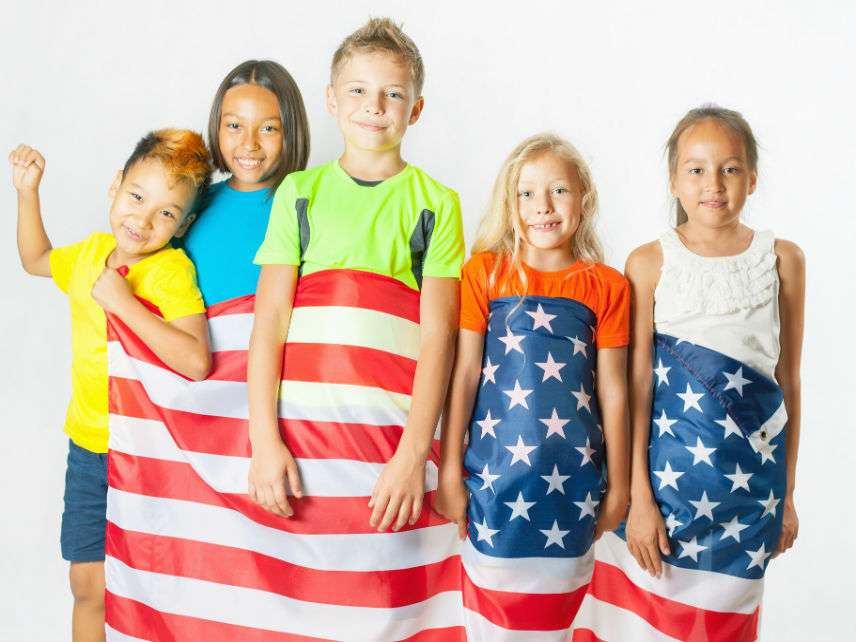Why Worrying Over a Minority Majority America Is Dumb
Let's do away with any questions regarding a person's race or ethnicity in the 2020 Census.

According to a 2015 U.S. Census Bureau report, "by 2044, more than half of all Americans are projected to belong to a minority group (any group other than non-Hispanic White alone)." That projection depends on Americans a generation hence quiescently staying in the ethnic and racial pigeonholes into which the census takers want to stuff them.
A new Pew Research Center study, "Hispanic Identity Fades Across Generations as Immigrant Connections Fall Away," finds that lots of people with Hispanic heritage do not identify themselves as being Hispanic when filling out Census survey forms. By the third generation, 56 percent of respondents simply identify themselves as American.
Also by the third generation, 75 percent of Americans with Hispanic ancestry live in households where English is the predominant language and in which 24 percent are bilingual. A 2012 Pew survey of Latinos on language use reported that 92 percent of second generation and 96 percent of third generation speak English well. That's basically the same trajectory followed by the descendants of earlier groups of immigrants.
The Census Bureau in 2020 may further allow us to test this idea of assimilation, considering allowing folks who check off white to mark boxes for groups like German, Irish, Italian, Polish, English and so forth.
However, parsing ethnicities that closely means that from the point of view of early-20th century nativists, America has been a majority minority country for a while now. As I have earlier argued:
By 2050, just as the earlier waves of Irish, Italian, Jewish, and Polish immigrants were assimilated, so too will today's Hispanic immigrants and their descendants be. For all intents and purposes, Hispanics will become as "white" as Irish, Italians, Jews, and Poles….It is my hope and belief that Americans of whatever ancestry living in 2050 will look back and wonder why ever did anyone care about the ethnic makeup of the American population. America is an ideal, not a tribe.
It bears noting that since the first census in 1790 the bureau has drawn a big distinction between white and black people living in this country. This is the result of the compromise in the Constitution in which slaves were counted as three-fifths of a person for purposes of apportioning seats in the House of Representatives and in the Electoral College. Consequently, in the early censuses, people were categorized as free white persons, all other free persons, or slaves. After the Civil War, the constitutional distinction between white and black citizens should no longer have mattered. Nevertheless, all censuses have maintained and enumerated white and black citizens in separate categories.
Apparently, on the principle that if it is acceptable for the census to divide citizens into black and white racial categories, other ethnic groupings are fair game, too. In 1890 the census asked whether people were white, black, mulatto, quadroon, octoroon, Chinese, Japanese, or Indian. The bureau also asked the number of years a person had lived in the U.S. and whether they were naturalized. In the five censuses from 1900 to 1940, the bureau simply asked each person's "color or race" and whether they were foreign-born.
In 1950, the census asked each person to identify as "White, Negro, American Indian, Japanese, Chinese, Filipino, Other race – spell out." In 1960, Hawaiian, Part-Hawaiian, Aleut and Eskimo were added to the list of possible ethnicities, presumably because Hawaii and Alaska had joined the Union the year before. It was not until 1970, when the bureau began asking, "Is this person's origin or descent (fill in one circle) Mexican, Puerto Rican, Cuban, Central or South American, Other Spanish, No, none of the above."
Let's consider a counterfactual. Between 1880 and 1920, more than four million Italians, five million Poles, two million more Germans*, and two million Jews immigrated to the U.S. By 1915, about 15 percent of the U.S. population was foreign-born (today it's about 13.5 percent). Imagine if the Census Bureau had set up and maintained national origin and ethnic categories for Italians, Poles, Germans and Jews in 1910; what percentage of Americans would today choose an ethnic identity more specific than the white option that has been part of every census since 1790?
The census began categorizing Americans as black or white based on an invidious Constitutional compromise that has long since been irrelevant. Here's a proposal: Let's do away with any questions with regard to a person's race or ethnicity in the 2020 Census.
*One of those was my great-grandfather Anton Pinn who left Rhineland-Palatinate in Bavaria in the 1880s to settle eventually in the German communities of central Texas. For what it's worth, Donald Trump's grandfather Friedrich Trump also left Rhineland-Palatinate at about the same time.


Show Comments (89)